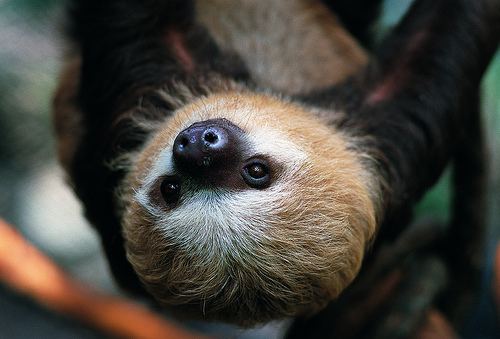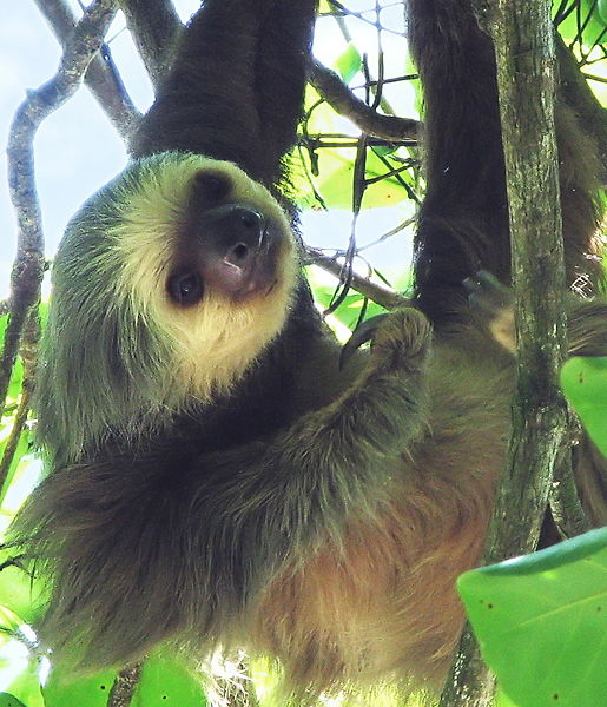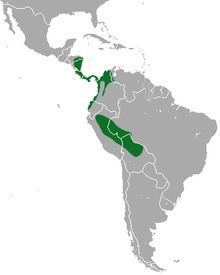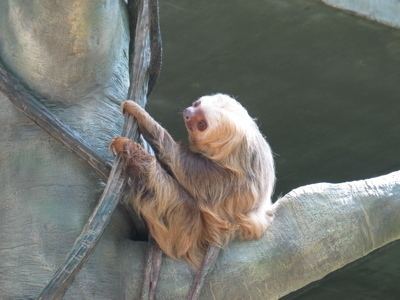Genus Choloepus | Phylum Chordata Family Megalonychidae Scientific name Choloepus hoffmanni Rank Species | |
 | ||
Similar Two‑toed sloth, Sloth, Brown‑throated sloth, Mammal, Linnaeus's two‑toed sloth | ||
Hoffmann's two-toed sloth (Choloepus hoffmanni) is a species of sloth from Central and South America.
Contents
It is a solitary, largely nocturnal and arboreal animal, found in mature and secondary rainforests and deciduous forests. The common name commemorates the German naturalist Karl Hoffmann.

Description

Hoffmann's two-toed sloth is a heavily built animal with shaggy fur and slow, deliberate movements. The fore feet have only two toes, each ending with long, curved claws, although three clawed toes are on each of the hind feet. Other features that distinguish it from three-toed sloths, which may be found in the same geographic areas, include the longer snout, separate rather than partially fused toes of the forefeet, the absence of hair on the soles of the feet, and larger overall size. The wrist of the sloth has developed some specific traits due to their slow, yet acrobatic motions. These evolved traits include diminution and distal migration of the pisiform bone, with a loss of contact with the ulna; reduction of the distal end of the ulna to a styloid process; and extremely reduced contact between the ulna and triquetral bone.

Hoffmann's two-toed sloth is, however, much easier to confuse with the related Linnaeus's two-toed sloth, which it closely resembles. The primary physical differences between the two species relate to subtle skeletal features; for example, Hoffmann's two-toed sloth has three foramina in the upper forward part of the interpterygoid space, rather than just two, and often – but not always – has fewer cervical vertebrae.

Adults range from 54 to 72 cm (21 to 28 in) in head-body length, and weigh from 2.1 to 9 kg (4.6 to 19.8 lb). Although they do have stubby tails, just 1.5 to 3 cm (0.59 to 1.18 in) long, this is too short to be visible through the long fur. The claws are 5 to 6.5 cm (2.0 to 2.6 in) long. Females are larger on average than males, although with considerable overlap in size. Their fur is tan to light brown in colour, being lighter on the face, but usually has a greenish tinge because of the presence of algae living in the hairs.
Its karyotype has 2n = 49–51 and FN = 61.
Distribution and habitat
Hoffmann's two-toed sloth inhabits tropical forests from sea level to 3,300 m (10,800 ft) above sea level. It is found in the rainforest canopy in two separate regions of Central and South America, separated by the Andes. One population is found from eastern Honduras in the north to western Ecuador in the south, and the other in eastern Peru, western Brazil, and northern Bolivia. Based on cytochrome c oxidase subunit I sequences, a divergence date of about 7 million years between these populations has been suggested.
Subspecies
The five recognised subspecies of C. hoffmanni are:
Behavior
Two-toed sloths spend most of their time in trees, though they may travel on the ground to move to a new tree. A study of sloths on Barro Colorado Island indicated that the Hoffmann's two-toed sloths there were almost exclusively nocturnal, even though in other locations they are known to be active during day. The authors attributed this in part to competition with the brown-throated sloth. They often move slowly through the canopy for about eight hours each night, and spend much of the day sleeping in tangles of lianas. They move only very slowly, typically at around 0.14 m/s (0.46 ft/s), although they can move up to 50% faster when excited. They are solitary in the wild, and, aside from mothers with young, it is unusual for two to be found in a tree at the same time.
The name "sloth" means "lazy", but the slow movements of this animal are actually an adaptation for surviving on a low-energy diet of leaves. These sloths have half the metabolic rate of a typical mammal of the same size. Sloths have very poor eyesight and hearing, and rely almost entirely on their senses of touch and smell to find food.
This species often exhibits exaggerated wobbling of the head. Another trait of this sloth is it often spits when the mouth opens. The saliva often accumulates on the lower lip, giving the creature a comical appearance.
Two-toed sloths hang from tree branches, suspended by their huge, hook-like claws. The clinging behaviour is a reflex action, and sloths are found still hanging from trees after they die. The sloth spends almost its entire life, including eating, sleeping, mating, and giving birth, hanging upside down from tree branches. Usually, sloths are found right side up when they descend to the ground to defecate, which they usually do about once every three to eight days. They will also ground themselves to urinate, change trees if they wish, or mate, as well as give birth. While terrestrial locomotion is usually thought to involve the sloth lying on the ground and pulling themselves forward, they have actually been seen walking on their palms and soles.
Sloths have many predators, including the jaguars, ocelots, harpy eagles, margays, and anacondas. If threatened, sloths can defend themselves by slashing out at a predator with their huge claws or biting with their sharp cheek teeth. However, a sloth's main defense is to avoid being attacked in the first place. The two-toed sloth can survive wounds that would be fatal to another mammal its size. The sloth's slow, deliberate movements and algae-covered fur make them difficult for predators to spot from a distance. Their treetop homes are also out of reach for many larger predators.
Their long, coarse fur also protects them from sun and rain. Their fur, unlike other mammals, flows from belly to top, not top to belly, allowing rainwater to slide off the fur while the animal is hanging upside down.
Hoffmann's two-toed sloth inhabits a range of different trees within its habitat, although it seems to prefer those with plentiful lianas and direct sunlight. They have a typical home range of about 2 to 4 ha (4.9 to 9.9 acres), and may spend most of their lives travelling between just 25 or so trees.
Life history
Courtship consists of the female licking the male's face and rubbing her genitals against the male's body. Gestation lasts between 355 and 377 days, and results in the birth of a single young. The birth takes place on either the ground or in the hanging position. Newborn sloths weigh 340 to 454 g (12.0 to 16.0 oz), and are precocial, already possessing long claws and able to cling to their mothers' undersides. They begin to take solid food at 15 to 27 days, and are fully weaned by 9 weeks. Although relatively quiet as adults, young sloths make loud bleating alarm calls if separated from their mothers.
In captivity, the two-toed sloth was seen giving birth by hanging upside down and attempting to pull the infant between her hind limbs and onto her abdomen. Other sloths were seen hanging under the mother and infant to protect the infant from falling.
Hoffmann's two-toed sloths reach sexual maturity at two to four years of age and have been reported to live up to 32 years in captivity.
Diet
Though two-toed sloths also eat fruits and flowers, most of their diets consist of tree leaves. They use their lips to tear off their food and chew with their peg-like teeth which have no enamel and are always growing. Although they are not true ruminants, sloths have three-chambered stomachs. The first two chambers hold symbiotic bacteria to help them digest the cellulose in their fibre-rich diets, while only the third chamber contains digestive glands typical of the stomachs of most other mammals. A sloth may take up to a month to completely digest a meal, and up to two-thirds of a sloth's weight may be the leaves in its digestive system.
Conservation status
Habitat destruction is probably causing a decrease in the wild Hoffmann's two-toed sloth population, but little reliable data is available on the number of wild individuals. Sloths and people have little contact with one another in the wild.
